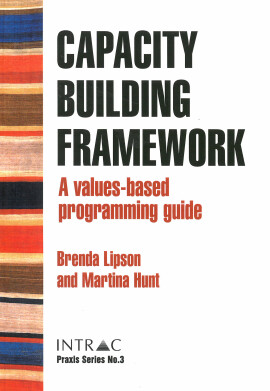
Capacity Building Framework
A values-based programming guide
The design and implementation of successful capacity building programmes involves a range of complex processes and considerations. This practical guide draws on INTRAC’s experience in capacity building consultancy and programme work and on its successful international training in capacity building. It adopts a step-by-step approach to the subject and introduces a new values-based model to enable decision makers to plan capacity-building interventions in a variety of contexts. The guide is divided into three parts:
Part One sets in place some core references regarding what capacity and capacity building are. It focuses on organisational capacity, and looks at models for understanding different types of organisations and how they develop.
Part Two focuses on the values and principles that shape the programme and emphasises the importance of understanding and making explicit some of the hidden values that affect the programme. It explores issues of values and power at the individual, relational and organisational levels. Part Two outlines how values and principles provide the reasons why organisations become engaged in capacity building.
Part Three explores the design of the programme. It takes the reader through a process of designing and implementing a programme, beginning by looking at the concept of working programmatically and then going through the different stages of the design process. Part Three considers issues of context and environment; the goal and objectives of the programme; the potential scope and levels of intervention, types of strategies and activities, resource issues and learning and accountability.
A range of tools, case examples and critical questions guide the reader through the conceptual and process issues raised, making it an ideal reference work for field staff, programme advisers and local capacity building practitioners.
Published: 2007
Pages: 192
Paperback: 9781905240142
Part One sets in place some core references regarding what capacity and capacity building are. It focuses on organisational capacity, and looks at models for understanding different types of organisations and how they develop.
Part Two focuses on the values and principles that shape the programme and emphasises the importance of understanding and making explicit some of the hidden values that affect the programme. It explores issues of values and power at the individual, relational and organisational levels. Part Two outlines how values and principles provide the reasons why organisations become engaged in capacity building.
Part Three explores the design of the programme. It takes the reader through a process of designing and implementing a programme, beginning by looking at the concept of working programmatically and then going through the different stages of the design process. Part Three considers issues of context and environment; the goal and objectives of the programme; the potential scope and levels of intervention, types of strategies and activities, resource issues and learning and accountability.
A range of tools, case examples and critical questions guide the reader through the conceptual and process issues raised, making it an ideal reference work for field staff, programme advisers and local capacity building practitioners.





